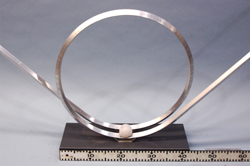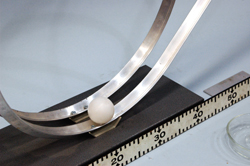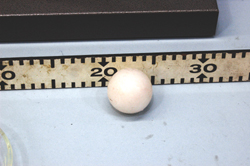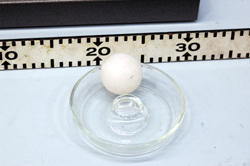|
Size: 3734
Comment:
|
← Revision 9 as of 2019-08-08 18:59:39 ⇥
Size: 4165
Comment:
|
| Deletions are marked like this. | Additions are marked like this. |
| Line 2: | Line 2: |
| ||<:30%>[:PiraScheme#Mechanics: Table of Mechanics Demonstration]||<:30%>[:MEEquipmentList: List of Mechanics Equipment & Supplies]||<:30%>[:Demonstrations:Lecture Demonstrations]|| | ||<30% style=""text-align:center" ">[[PiraScheme#Mechanics|Table of Mechanics Demonstration]] ||<30% style=""text-align:center" ">[[MEEquipmentList|List of Mechanics Equipment & Supplies]] ||<30% style=""text-align:center" ">[[Demonstrations|Lecture Demonstrations]] || |
| Line 5: | Line 6: |
| '''Topic and Concept:''' | |
| Line 6: | Line 8: |
| '''Topic and Concept:''' Work and Energy, [:WorkEnergy#ConservationOfEnergy: 1M40.Conservation of Energy] |
. Work and Energy, [[WorkEnergy#ConservationOfEnergy|1M40.Conservation of Energy]] '''pira200 Listed''' |
| Line 10: | Line 13: |
| * '''Cabinet:''' [:MechanicsCabinet:Mechanic (ME)] | * '''Cabinet:''' [[MechanicsCabinet|Mechanic (ME)]] |
| Line 13: | Line 17: |
| attachment:LoopTheLoop01-400.jpg | {{attachment:LoopTheLoop01-400.jpg}} |
| Line 18: | Line 22: |
||<:style="width: 60%" :40%>'''Equipment'''||<:30%>'''Location'''||<:25%>'''ID Number'''|| |
||<40% style="" & quot; ;text-align:center" ">'''Equipment''' ||<30% style=""text-align:center" ">'''Location''' ||<25% style=""text-align:center" ">'''ID Number''' || |
| Line 21: | Line 24: |
| ||Loop the Loop||ME, Bay T7|| || ||Hard Nylon Ball||ME, Bay A2, Shelf #2|| || |
||Loop the Loop ||ME, Bay T6 || || ||Hard Nylon Ball ||ME, Bay A2, Shelf #2 || || |
| Line 26: | Line 29: |
| '''''Important Setup Notes:''''' | '''''Important Setup Notes:''''' |
| Line 32: | Line 37: |
| '''Setup and Procedure:''' | '''Setup and Procedure:''' |
| Line 37: | Line 42: |
| 1. A meter stick maybe useful. | |
| Line 40: | Line 45: |
| Line 43: | Line 49: |
'''Discussion:''' |
'''Discussion:''' |
| Line 48: | Line 53: |
| See the link below for a detailed calculation of the minimum height necessary for which the ball can fall freely and make it around the loop. | See the references below for a detailed calculation of the minimum height necessary for which the ball can fall freely and make it around the loop. |
| Line 50: | Line 55: |
| ||attachment:LoopTheLoop03-250.jpg||attachment:LoopTheLoop04-250.jpg||attachment:LoopTheLoop05-250.jpg||attachment:LoopTheLoop06-250.jpg|| | This is also the basic building blocks for amusement rides and roller-coasters. || {{attachment:LoopTheLoop03-250.jpg}} || {{attachment:LoopTheLoop04-250.jpg}} || {{attachment:LoopTheLoop05-250.jpg}} || {{attachment:LoopTheLoop06-250.jpg}} || |
| Line 53: | Line 62: |
| * [https://www.youtube.com/user/LectureDemostrations/videos?view=1 Lecture Demonstration's Youtube Channel] | * [[https://www.youtube.com/user/LectureDemostrations/videos?view=1|Lecture Demonstration's Youtube Channel]] |
| Line 57: | Line 67: |
| * [https://en.wikipedia.org/wiki/Conservation_of_energy Conservation of Energy - Wikipedia] * [http://physics.bu.edu/~redner/211-sp06/class-energy/looptheloop.html Calculating the Minimum Height from which the Ball Can Drop and Get Around the Loop] * [http://www.physicsclassroom.com/mmedia/circmot/rcd.cfm Forces on a Roller Coaster Loop-the-Loop] |
* [[https://en.wikipedia.org/wiki/Conservation_of_energy|Conservation of Energy - Wikipedia]] * [[http://physics.bu.edu/~redner/211-sp06/class-energy/looptheloop.html|Calculating the Minimum Height from which the Ball Can Drop and Get Around the Loop]] * [[http://www.physicsclassroom.com/mmedia/circmot/rcd.cfm|Forces on a Roller Coaster Loop-the-Loop]] |
| Line 61: | Line 71: |
| [:Instructional:Home] | [[Instructional|Home]] |
Loop the Loop, 1M40.20
Topic and Concept:
Work and Energy, 1M40.Conservation of Energy
pira200 Listed
Location:
Cabinet: Mechanic (ME)
Bay: T7
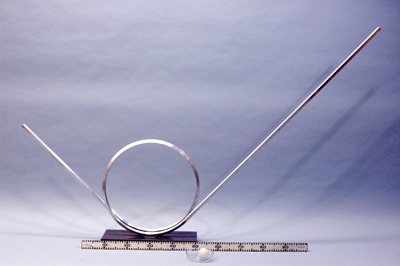
Abstract:
A ball is placed at various initial heights and allowed to roll down an incline and around a loop, assuming the ball has enough energy.
Equipment |
Location |
ID Number |
|
|
|
Loop the Loop |
ME, Bay T6 |
|
Hard Nylon Ball |
ME, Bay A2, Shelf #2 |
|
Important Setup Notes:
- For fun, practice a few times before hand to gain a sense of the critical height for making a complete loop. (Then mark that spot.)
- Note that the tack as a whole is not symmetrical. One ramp is longer then the other.
- The ball will not compete the loop if started at the top of the shorter ramp.
- Listen to the frictional sound of the ball on the track to see if ball makes or breaks contact with the top of the loop.
Setup and Procedure:
- Orientate the loop the loop on the table so the audience can see the ball roll around the track.
- A 1 1/2" hard nylon ball is placed on the track at it lowest point for the instructor to use.
- Place the ball at varying heights on the longer ramp and then release.
- A meter stick maybe useful.
Cautions, Warnings, or Safety Concerns:
- If the ball is placed too low on the track, the ball will not make it around the loop.
- If the ball is placed too high on the track, the ball will fly off the other end of the track after completing the loop.
Discussion:
When the ball is brought up to some point on the track, it is given gravitational potential energy m*g*h where m is the ball's mass, g is the acceleration due to gravity, and h is the height relative to the bottom of the loop. Throughout the demonstration, this quantity will be the total energy of the ball, it it will remain constant as per the conservation of energy, neglecting friction. The force that "compels" the ball to turn in a loop is the normal force of the track on the ball. That is to say the centripetal force is provided by the normal force. [ N = m * v2/ R ] Where N is the normal force, v the speed of the ball, and R the radius of the loop. Using this information, it is then possible to calculate a minimum speed for the ball to have at the top of the loop without falling or slipping off the track. Subsequently, a minimum initial height can be calculated, neglecting friction. As it turns out, this critical height is hcrit = (5/2) * R
See the references below for a detailed calculation of the minimum height necessary for which the ball can fall freely and make it around the loop.
This is also the basic building blocks for amusement rides and roller-coasters.
|
|
|
|
Videos:
References:
